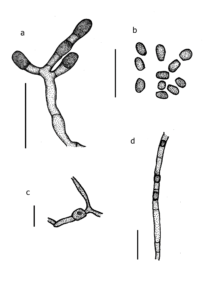Fungalpedia – Note 247, Sigleria
Sigleria Hirooka, Tanney & Seifert, in Hirooka, Tanney, Nguyen & Seifert
Citation when using this entry: Thakshila et al. 2024 (in prep) – Fungalpedia, Onygenales, Eurotiales, and Verrucariales.
Index Fungorum, Facesoffungi, MycoBank, GenBank, Fig. 1
Classification: Spiromastigaceae, Onygenales, Eurotiomycetidae, Eurotiomycetes, Fungi
Sigleria was introduced by Hirooka et al. (2016) to accommodate S. carmichaelii, as the type species, which was isolated from settled house dust from a private residence in the Federated States of Micronesia. This genus consists with two species, S. carmichaelii and S. amenda. Only an asexual state has been reported. Based on phylogenetic analysis of ITS sequences, Sigleria formed a distinct clade in Spiromastigaceae (Hirooka et al. 2016). Sigleria is characterized by septate, thin-walled, and branched hyphae. Conidiophores usually occur in aerial hyphae with pyramidal branching, and tend to have opposite branching patterns. Conidiogenous hyphae are branched, thick-walled, and produced basipetal septa to form arthroconidia. Terminal single lateral conidia occur in main fertile hyphae or short lateral branches and are thick-walled and subglobose to clavate with a truncate base. Arthroconidia are thick-walled, cylindrical, cuboid, or doliiform. Chlamydospores are produced terminally or intercalary and are thick-walled, unicellular, solitary and subglobose (Hirooka et al. 2016). Morphologically S. carmichaelii and S. amenda are similar, however, S. carmichaelii grows more slowly than S. amenda in most media and the optimum growth of S. carmichaelii occurs at 25 °C, while it is 30 °C for S. amenda. Based on ITS sequences, S. carmichaelii is distinct from S. amenda. Sigleria is morphologically similar to Spiromastix species. However, the unilateral branching pattern of Spiromastix differs from that of Sigleria and both genera have different growth rates (Hirooka et al. 2016).
Type species: Sigleria carmichaelii Hirooka, Tanney & Seifert
Other accepted species:
- Sigleria amendiana Hirooka, Tanney & Seifert
Figure 1 – Sigleria carmichaelii (DAOMC 250069, ex-type culture) a-c Conidiophore and conidia. d Chlamydospores. Scale bars: a–d = 10 μm. Redrawn from Hirooka et al. (2016).
References
Entry by
Subasingha A. D. Thakshila, Center of Excellence in Fungal Research, School of Science, Mae Fah Luang University, Chiang Rai 57100, Thailand
(Edited by Chitrabhanu S. Bhunjun, Kevin D. Hyde, Samaneh Chaharmiri-Dokhaharani, & Achala R. Rathnayaka)
Published online 22 April 2024
